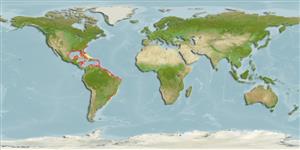Preferred temperature (Ref.
123201): 19.5 - 27.2, mean 24.7 °C (based on 105 cells).
Phylogenetic diversity index (Ref.
82804): PD
50 = 0.6250 [Uniqueness, from 0.5 = low to 2.0 = high].
Bayesian length-weight: a=0.00089 (0.00039 - 0.00204), b=3.00 (2.80 - 3.20), in cm total length, based on LWR estimates for this (Sub)family-body shape (Ref.
93245).
Trophic level (Ref.
69278): 4.1 ±0.6 se; based on size and trophs of closest relatives
Widerstandsfähigkeit (Ref.
120179): niedrig, Verdopplung der Population dauert 4,5 - 14 Jahre. (Preliminary K or Fecundity.).
Fishing Vulnerability (Ref.
59153): Very high vulnerability (90 of 100).
Nutrients (Ref.
124155): Calcium = 21 [11, 34] mg/100g; Iron = 0.408 [0.244, 0.887] mg/100g; Protein = 18.8 [16.6, 21.4] %; Omega3 = 0.0979 [, ] g/100g; Selenium = 64.2 [35.6, 124.3] μg/100g; VitaminA = 33.6 [10.0, 102.6] μg/100g; Zinc = 0.775 [0.554, 1.093] mg/100g (wet weight);
